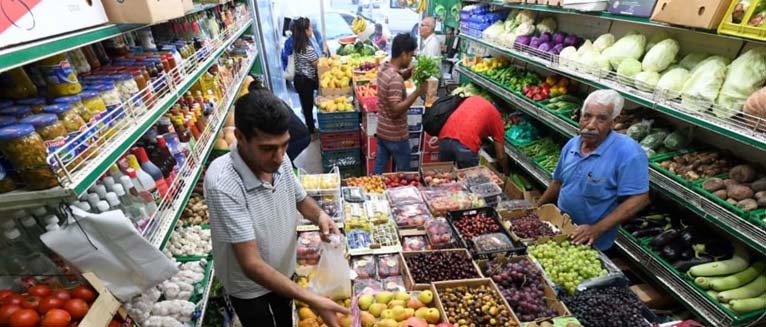Srinagar:WTNS:Calling Iranian apples trade in India illegitimate is the act of sheer stupidity as Iran’s vast untapped hydrocarbon reserves and India’s ever-growing energy consumption form the basis of India-Iran economic cooperation. However, the two countries are also invested in strengthening their regional connectivity infrastructure to bolster trade and commerce.
Agha Syed Amin Mousvi.
It is said that he who controls the spice controls the universe as the fact has been seen that the global apple trade has been stagnating for several years in a row under the influence of competition from berries and exotic fruits. While global apple production is growing by 2% per year, global apple exports are declining by 1% per year.
Iran is currently actively pushing other suppliers out of this market, since it has the ability to export products at a very competitive price despite the embargoing squeezing-pall over the economical wealth.
Among the large exporting countries that have reduced the volume of apple exports in the past five years, are France, Italy and the United States. In general, France is the world leader in terms of apple exports decline.
Interestingly, less than 20 years ago, France was the global leader fresh apple exports, selling 700 thousand tons of apples to the foreign markets. At that time, Italy and China exported about 100 thousand tons less, the USA –
In India many countries explore their exotica economical prowess by exporting commodities which includes mainly apples.
The opulent exporters include Australia Turkey and USA based apple industries have invaded the Indian emerging markets in era of global economical stiff competitions but when it comes about Iranian apples , The fruit growers of Jammu and Kashmir remains up in arms against the Iranian apples .
The time demands for deeper analytical insights figure-out the quality which is required to overtake the market demands.
The tree top markets for Iran’s apple fruit were Iraq (18, 5000 tones), Turkmenistan (57,000 tones) and UAE (56.5, 000 tones). The other markets standing at the fourth to tenth place were: Afghanistan, Pakistan, India, Egypt, Kazakhstan, Turkey and Bahrain. In 2012, some other countries imported apple fruit from Iran, some of which are: Georgia, Saudi Arabia, Tajikistan, Oman, Armenia, Syria, Liberia, Kuwait, Azerbaijan, Cypress, Britain, Qatar and Malaysia.
An apple grower hailing from valley’s famous apple town Sopore told Wilayat times
“Kashmir grown- apples finds less market due to the export markets of many foreign countries such as Turkey Australia Iran , but I think the king of all luscious and appetizing apples are best from Iran. Iranian apples have the potential to push away many other apple industries”
While posing a contrary question that many critics have revealed that Iranian apples are at large-scale rotten, dry, juiceless and have been the victim of sooty blotch and fly speak with scalp and black rot canker .
At this the farmer, vehemently denied all these critical revealing called Iranian apple the king of all apples , he cited his own example , “my children brought some Iranian apples which were precisely incredibility dewy and luscious. “we ate Iranian apples our mouths were filled with juices and ratings for them”.
“It seems awkward when we blame others for overtaking us by their business strategies is it just Iranian apples which are flooding the Indian Nexus of markets ? Nah! but there is the rapturous existence of other foreign apples in India which are pushing away the Kashmiri apples in era of commercial struggling rivalry” Said Haji Mohammad Subhaan hailing from Shopian Kashmir.
“Iranian apples have became the fixture of talks ragging from the local news industries to nation-wide by denying the facts of economical democracy and the age of commercial struggling , giving it the ancestral maliciousness edge is not the rule of trade, admitting the hallows of Iranian hybridization in terms of the mass production of fruits , Saffron , Olive oils , carpets, gas and other resources can the era of gusty courage”
Although, There are different types of rice in Iran such as Basmati, Gerde, Domsiah (literally meaning black-tail, because it’s black at one end), Champa, Doodi (smoked rice), Lenjan and Tarom. However, interestingly the majority of Iranian people prefer Indian rice as, the fact they consider it productive in terms of its quality and taste undoubtedly, it is expensive for them .
“Many Iranians favour Indian rice despite , having their rice branded and noted for rich in carbohydrates and it very smooth in digestion ,develops less fat but gives you ample nutrients still they prefer Indian rice, we being as Kashmiri can easily make a big difference between the Twain types of rice , according to us Iranian rice in exceptional but it all depends on the taste if people” said few Kashmiris pursuing education there.
Calling Iranian apples trade in India illegitimate is the act of sheer stupidity as Iran’s vast untapped hydrocarbon reserves and India’s ever-growing energy consumption form the basis of India-Iran economic cooperation. However, the two countries are also invested in strengthening their regional connectivity infrastructure to bolster trade and commerce.
While talking with some media outlets, Aijaz Bhat, Director General of Horticulture for the Government of Jammu and Kashmir said that the issue had been taken with up with higher authorities and action would come soon but on the same time apple growers are exaggerating the situation unnecessarily. Yes, there is some problem with Iranian apples but that`s hardly going to impact our homegrown fruit in J&K.
Trade treaty negotiation
Negotiations for an India-Iran bilateral Preferential Trade Agreement (PTA) are ongoing (rounds have already been held as of June 2021), with a focus on diversifying the bilateral trade basket to include manufacturing, services, and light engineering items. The PTA, which is expected to materialize soon, will allow the two countries to cut tariffs on each other’s products. Since Iran is not a World Trade Organization (WTO) signatory, there is no obligation to keep the tariff rates within a specific threshold as prescribed by the WTO.
Indian exports to Iran
Major Indian exports to Iran include semi/wholly milled rice, black tea, fertilizers, organic/inorganic/agro chemicals, machinery and instruments, metals, primary and semi-finished iron and steel, pharmaceutical and fine chemicals, processed minerals, polyester yarn and woven fabrics, and rubber manufactured products.
India caters to more than one-third of Iran’s demand for sugar and rice. Iran imported around 700,000 tons of basmati rice from India during the first quarter of 2020. Other agricultural exports to Iran include barley, sesamum seeds, cane sugar, and oil cake etc. In FY19, India’s export basket to Iran was valued at US$3.5 billion and in the first 10 months of FY20, this value stood at US$2.8 billion.
Other potential items that can enhance Indian exports to Iran are machinery and instruments, electrical, electronic equipment, vehicles other than railway, tramway, plastics and plastic articles, optical, photo and technical apparatus, pharmaceutical products, animal vegetable fats and oil, ceramic products and pearls, and precious stones.
Indian imports from Iran
Major Indian imports from Iran include crude oil, inorganic/organic chemicals, fertilizers, plastic and articles, glass and glassware, natural or cultured pearls, precious or semiprecious stones, leather, etc. Agricultural imports from Iran comprise of almonds, pistachios, dates, and saffron, etc. In FY19, imports from Iran amounted to US$13.5 billion. In the first 10 months of FY20 (April 2019-January 2020), this value dropped to US$1.35 billion. The main reason for this drastic fall was no import of crude oil from Iran since May 2019.
Business prospects will depend on how regional stakeholders behave
In the period between June 1990 to March 2021, the cumulative Indian foreign direct investment (FDI) in Iran stood at US$5,750.20 million. Large Indian companies, such as ESSAR, OVL, and Tata Steel, etc., have a presence in Iran. (Comparatively, Iranian cumulative FDI into India from 1997 to 2019 stood at just US$905.62 million.)
Iran’s vast gas, oil, and hydrocarbon reserves as well as its strategic location makes it an attractive destination for India.
The recent US$400 billion deal between Iran and China to develop Iran’s infrastructure and energy in lieu of continual and discounted oil supply to China irked India and may incentivize New Delhi to be more aggressive in its pursuit of trade and commerce relations with Tehran.
“Iran imported around 700,000 tons of basmati rice from India during the first quarter of 2020. Other agricultural exports to Iran include barley, sesamum seeds, cane sugar, and oil cake etc.”
With the changing situation in Afghanistan, India and Iran find themselves at an opportune moment to explore the convergence of their mutual interests.
Iran and Afghanistan have agreed to facilitate bilateral trade and strengthen economic ties, the latter’s interim administration run by the Taliban announced yesterday as it’s spokesman Zabihullah Mujahid, who is also the acting deputy information and culture minister, said in a statement that a meeting was held between Afghan and Iranian officials “with the aim of strengthening economic ties and providing necessary facilities for trade issues between the two countries.”
As many as 16 points were agreed upon including an increase in working hours to facilitate the flow of goods at the Islam Qala-e-Dogharoon border, reviewing existing tariffs on goods and services, as well as discussion on issues with fuel supply.
Yesteryear’s last month , foreign media reported that Tehran resumed fuel exports to Afghanistan after weeks and months of political uncertainty.
While the two delegations agreed to hold talks on infrastructure issues, the statement added that Iran “will cooperate in the field of health and tourism.”
The two sides have maintained close contact in recent weeks, even though Tehran has so far stopped short of recognizing the new Taliban government, in line with the international community’s stand.
The neighbouring countries have also been locked in a longstanding water dispute, which has largely prevented them from realizing the vast potential of bilateral trade ties.
The end is not here if the fact is true in the nature that the Kashmiris apple business has been marooned by Iranian apples , with the sole aim of hampering and plundering the economical stature of the state obviously Iran is just as the same responsible for declining the lives of Kashmiris as enriching it’s cultural diversity keeping the ancestral zeal glowing on from the beginning of Islamic jingling in valley prior to its Rishi culture.
The Story first appeared in the print edition of Weekly Wilayat Times on 17th January 2022



